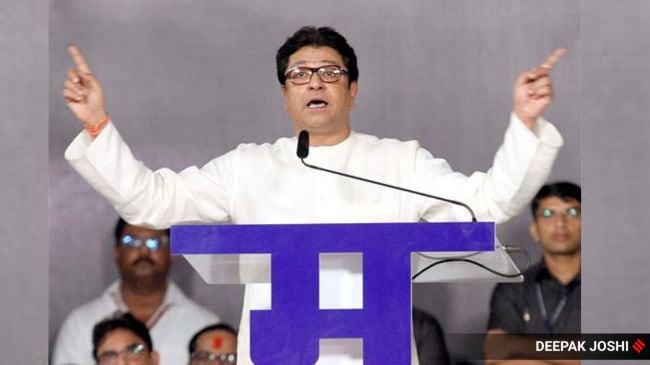Opinion A question mark hangs over Raj Thackeray and MNS’s future
Raj has little space today in either the overcrowded Hindutva camp or in the domain of linguistic regional politics
 Raj Thackeray delivered a strong message to his party workers, urging them to bury internal differences and focus on the upcoming Brihanmumbai Municipal Corporation (BMC) elections (Express Photo/Deepak Doshi)
Raj Thackeray delivered a strong message to his party workers, urging them to bury internal differences and focus on the upcoming Brihanmumbai Municipal Corporation (BMC) elections (Express Photo/Deepak Doshi) Why was Raj Thackeray’s recent agitation, in which he called on his party workers to slap those in the state who refuse to speak Marathi, a complete non-starter? Why did it barely resonate with the Marathi manoos? Besides highlighting Raj’s brand of politics, this latest misadventure also raises a larger important question: Is this the end of the sons-of-the-soil proposition in Maharashtra?
Before delving into this question, however, the situation calls for a comment on the younger Thackeray and his hit-and-run style of politics. Raj’s political outfit, the Maharashtra Navnirman Sena (MNS) will complete two decades of its existence next year. It initially received an overwhelming response: A mere three years after its foundation, in its maiden election in 2009, the MNS sent 13 MLAs to the 288-member Maharashtra Assembly, and Raj was the new star on the state’s political horizon. But just 15 years later, in the 2024 assembly elections, the party drew zero. This spectacular decline not only underlines Raj’s inability to stay the course, it also puts a question mark on his party’s longevity.
Treading in the footsteps of his mentor, Bal Thackeray, Raj founded the MNS with a one-point agenda: To protect the “sons of the soil” from “outsiders”. For Thackeray Sr, when he founded the Shiv Sena in the 1960s, south Indians — referred to as “Madrasis” — epitomised the “outsiders”, seen as stealing jobs from Marathi youth. By the time Raj, who was as much of a maverick as his uncle, set up his outfit in 2006, the “Madrasis” were replaced by “bhaiyyas”. If in the 1960s, anyone who came from the south of the Kaveri was dubbed a “Madrasi”, after 2000, every north Indian in Mumbai was considered a “bhaiyya”. Unlike south Indians back then, who were accused of grabbing office jobs — like that of stenographers and typists etc — the “bhaiyyas” primarily keep the wheels of the much-vaunted service sector running, working as drivers, running laundries and even ragpicking. Both south and north Indians were hapless targets. The similarity between the two parties, however, ends there.
Although Bal Thackeray agitated against south Indians in Mumbai, he also undertook constructive activities, such as setting up the Sthaniya Lokadhikar Samiti (a body to preserve the rights of locals) which trained Maharashtrian youth to make them employable. Led by loyal Sena men like the late Sudhir Joshi and Pramod Nawalkar, the Sthaniya Lokadhikar Samiti was to the Shiv Sena what the RSS is to the BJP today. It not only helped the party grow, it also helped it create brand ambassadors in the rising middle class. So while, on the one hand, Thackeray Sr brought the lumpen element into the party, on the other hand, he won over mild-mannered middle-class men and women on a large scale. The Sthaniya Lokadhikar Samiti helped lakhs of Marathi youth by helping them prepare for job openings in large organisations such as Air India, Reserve Bank Of India, Mahindra and Mahindra and many more. Bal Thackeray used his political clout to “convince” business leaders and industrialists to recruit from the ranks of the Samiti. For years, the Samiti was Mumbai’s de facto Employment Exchange. This fact about Bal Thackeray, little-known outside Mumbai, can explain the initial goodwill his party earned.
While Raj tried aping the militant style of his alma mater, the Shiv Sena, he failed to create his own version of the Sthaniya Lokadhikar Samiti. This failure alone has severely restricted Raj and his party from reaching out to the Marathi middle class, which is looking for a meaningful role, not just pelting stones and slapping helpless migrants. Besides, even after nearly 20 years of existence, Raj remains the sole face of the party. Add to this the fact that the party swings between Marathi pride and Hindutva. Having started on the right note, Raj lost his way, and jumped onto the Hindutva bandwagon. From being a bitter critic of Narendra Modi and his politics, the MNS chief became a Hindutva torchbearer — so much so, that he started presenting himself in full saffron and his party sought to brand him as Marathi Hindu Hriday Samrat (Marathi Hindu heartthrob/icon). The BJP wasted no time in welcoming this neoconvert into its fold, although it never aligned with him officially. This painted the MNS as the B-team of the BJP, damaging Raj’s reputation. Neither did the new love for Hindutva deliver any electoral dividends. Having thus failed, Raj may find that he has little space today in either the overcrowded Hindutva camp or in the domain of linguistic regional politics.
This brings us to the question about whether the decline of the MNS means the end of “sons-of-the-soil” politics in Maharashtra. The answer is no. Maharashtra is waiting for a truly committed regional party and a leader who can go beyond eye-catching, headline-grabbing agitations and help locals stay relevant in a highly competitive economy. Having realised this, Raj was compelled to halt his latest agitation midway. Not only had it failed to earn any sympathy, it also alarmed the state machinery, as it threatened Maharashtra’s already fragile investment climate. Chief Minister Devendra Fadnavis appeared in no mood to let Raj upset his applecart. It also triggered a severe backlash from Maharashtrians who disapproved of these violent theatrics. Thus, the agitation ended with a whimper, one that signals Raj Thackeray’s continuing political slide.
The writer is editor, Loksatta



